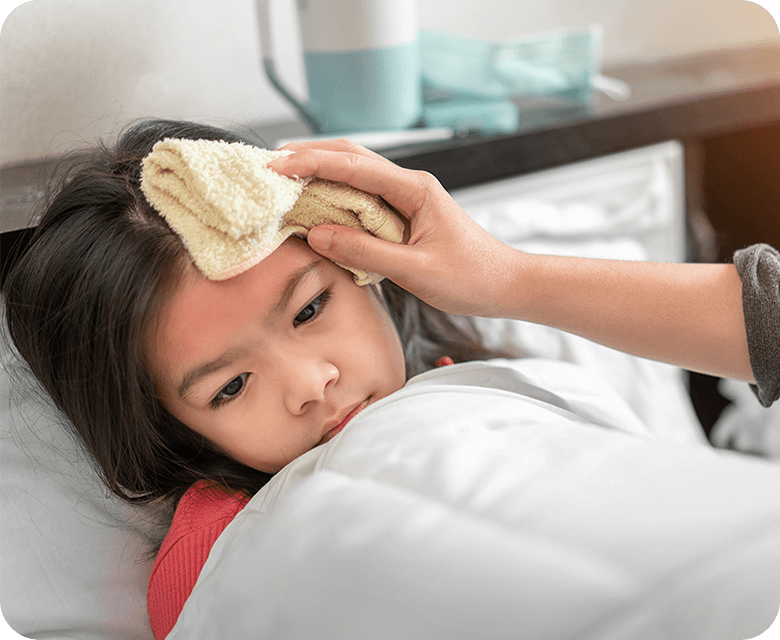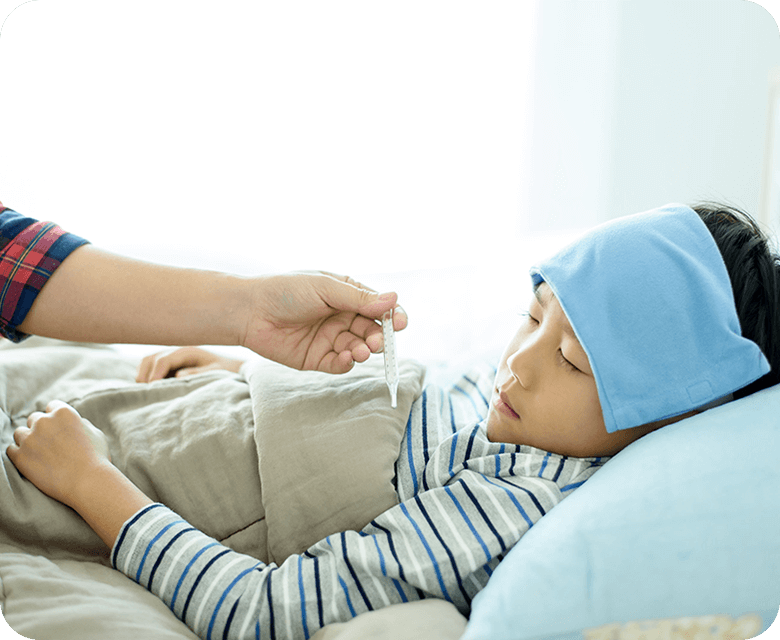What to expect and what you can do
If you're worried your child may have a fever, don’t be alarmed. An elevated temperature is common when your child is ill and chances are that it’s not serious.
To be on the safe side, however, you’ll want to learn about what may be causing your child’s fever, how to reduce their temperature and when to get medical attention.
3 signs of fever in children
1. Their skin feels hot Does their forehead, tummy or back feel overly warm?
2. Their cheeks are pink Do they look unusually flushed or red-faced?
3. They’re sweaty Does their skin feel sweaty for no reason, or clammy?

How can I tell if my child has a fever?
The quickest way to determine whether your child has a fever is to take their temperature. You may have a thermal (forehead) or digital ear thermometer, which are suitable for older children and adults. If they’re under five years old, however, it’s best to take it in their armpit.
Your child’s normal temperature naturally fluctuates slightly but if it goes higher than 37.5°C then, yes, your little one has a fever.
What are other signs of fever in toddlers and children?
Don’t have a thermometer handy? No worries, there are several other tell-tale signs of fever in children. When your kid’s got a fever, you’re likely to see changes in their mood and behaviour that can signal to you that something isn’t quite right.
While every child is unique, and you know your child best, here are some other common symptoms when a child has a fever.
- Being irritable They may be moodier than usual.
- Shivering Do they have the chills?
- Sweating Their skin may be sweaty or clammy.
- Headache They may complain of headache.
- Feeling tired Are they less energetic than usual?
- No appetite Are you struggling to get them to eat?
- Dehydration Check to see if their mouth is dry.
What can cause a high temperature or fever in children?
Fever is the body’s natural way of fighting an infection. It’s likely they’ve just caught the flu or another common childhood illness such as an ear infection. While rare, a fever can also be caused by a more serious infection like meningitis. Call your doctor immediately if you spot other symptoms, such as a stiff neck, vomiting, diarrhoea or a rash.
As a parent, you’re naturally worried, and it’s never nice to witness your child in discomfort, but rest reassured that the fever itself is not harmful. Your child’s temperature will return to normal once the underlying illness is treated. Until then, keep a close eye on them and do your best to make them comfortable. Don’t hesitate to consult a doctor if you’re concerned or feel something isn’t right.

What is a normal temperature for children?
A normal temperature for children is about 36.4°C to 37.2 °C. What is considered ‘normal’ is not a specific number but a range. Your child’s body temperature will fluctuate slightly in response to environmental factors like the room temperature or the weather. Your child may feel also warmer for the simple reason that they have a woolly jumper on.

How can I help relieve my child’s discomfort?
There are several home remedies (such as time, rest and loving care are usually the best remedies) that can help bring your child’s temperature back down so they’re more comfortable. Always defer to your doctor’s advice. You may be able to use over-the-counter pain-relief medicines containing paracetamol to help bring down your child’s fever.
How can I reduce my child’s fever?
To help keep your child comfortable when they have a fever, there are a few things you can try:
- A cool compress Dampen a washcloth with cool (not too cold) water and place it on their forehead.
- A lukewarm sponge bath Using room temperature (not cold) water, gently wipe them down their forehead, limbs and torso with a soft cloth.
- Light clothing Make sure your child’s not overdressed, for example choose cotton instead of flannel pyjamas. If they start to shiver, you can offer them a light blanket to make them more comfortable.
- Lots of fluids It’s important to stop your kiddo from becoming dehydrated.
- Over-the-counter pain relief Paracetamol can be used to bring down fever if your baby is older than one month. Always follow the dosage guidelines on the label for your child’s age and weight. Also take care not to give them more than one medicine containing paracetamol.
.png?auto=format)
If your infant is less than three months old and is showing signs of illness or has a fever, bring them to the attention of your paediatrician.
If your child’s fever doesn’t improve or worsens, or if they develop additional symptoms, contact their doctor and have them checked. You’re the expert when it comes to your kid, so you should always trust your instincts if they’re telling you that something is wrong.
High fever in children can be a medical emergency, so seek urgent medical advice if your child has any of the following symptoms.
- A temperature higher than 40°C
- A stiff neck, headache or light sensitivity
- A rash, especially if it doesn’t fade when a glass is pressed on it
- A seizure or convulsions
- Lethargy or listlessness
- Persistent vomiting or diarrhoea
- Extreme discomfort or irritability




